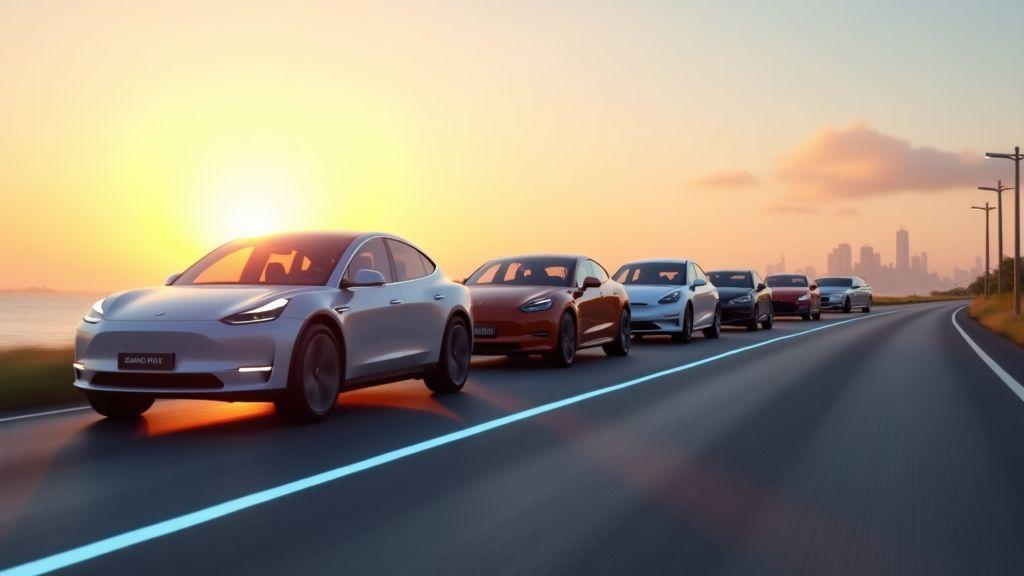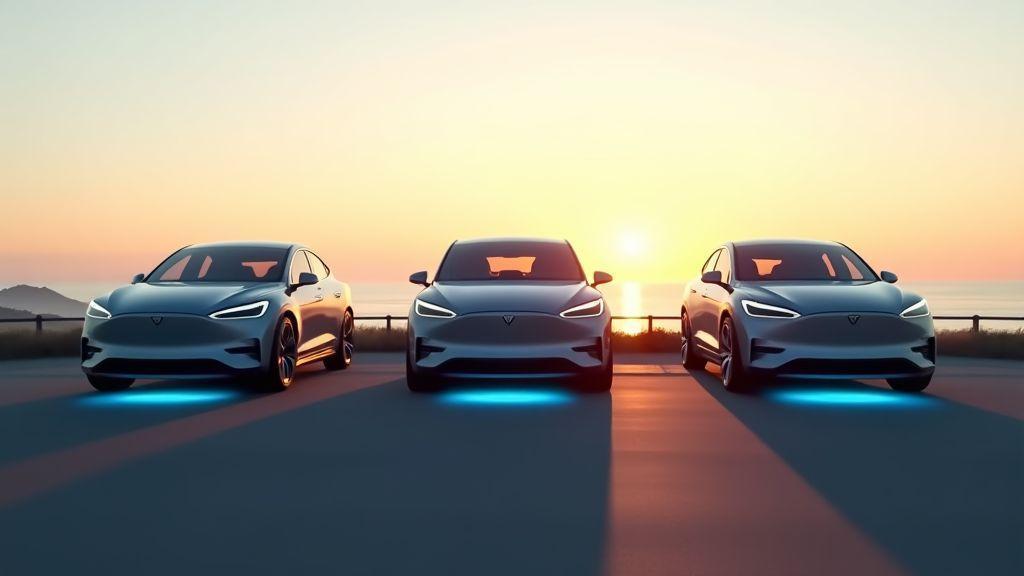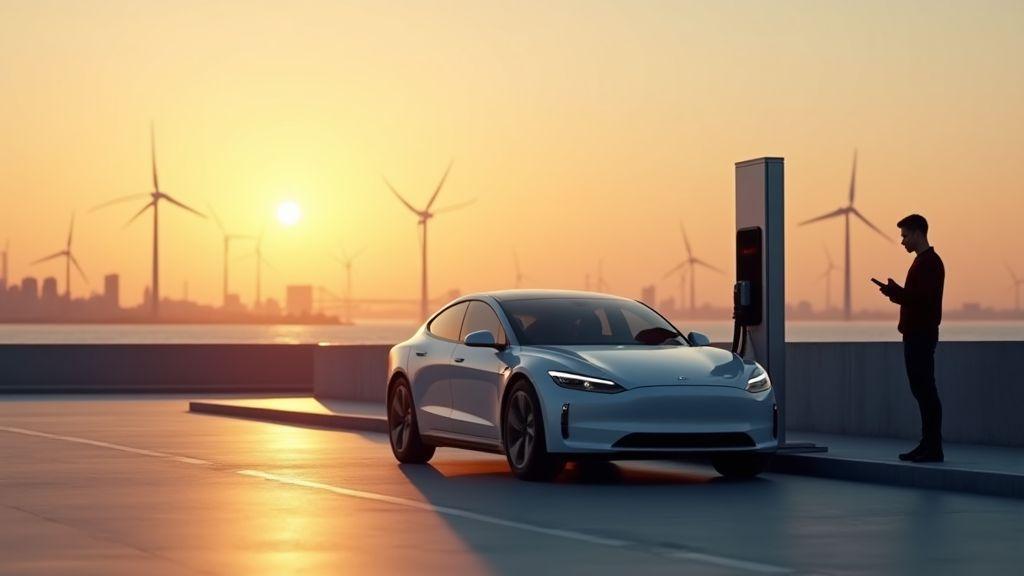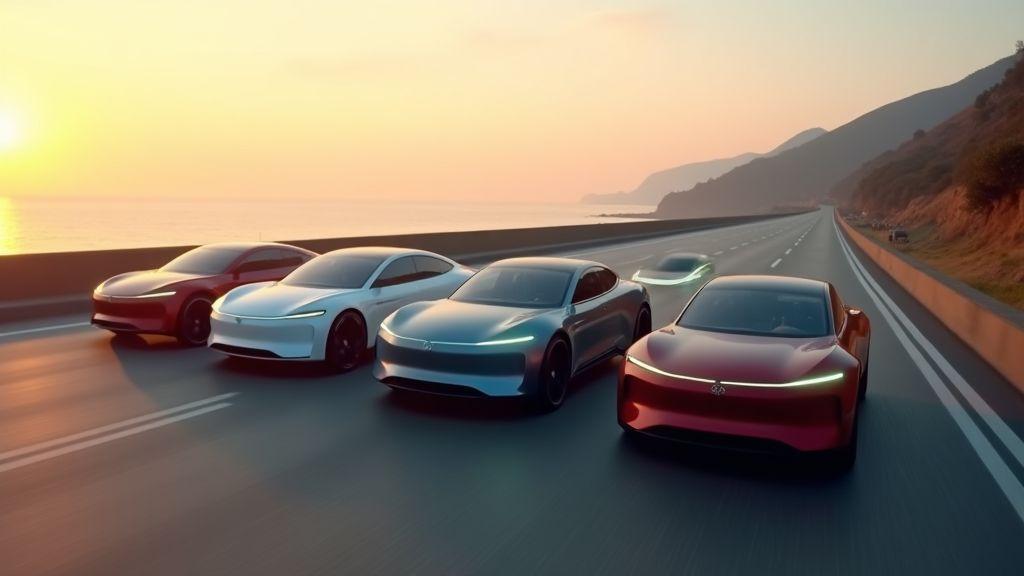Top five Electric Cars with the Longest Range in 2026 — you will get a clear, practical guide to how EPA range ratings shape rankings, how to read EPA labels, which real-world factors like speed, temperature, and load change those claims, simple tips to improve range, how to compare efficiency and battery size, the charging and road trip practicality of the leading models, and the ownership costs, safety features, and resale points you should weigh when choosing your next long-range EV.
Key Takeaway
- Pick models that deliver the longest real driving range.
- Verify EPA range and real-world range for your routes.
- Plan charging stops using fast chargers on long trips.
- Compare price, incentives, and battery warranty before buying.
- Test drive to confirm comfort and actual efficiency.

How EPA Range Ratings Determine Top 5 Electric Cars with the Longest Range in 2026
The EPA range rating is the main number you see when shopping for long-range EVs. It comes from a standard test that mimics stop-and-go city driving and steady highway cruising. That single figure puts cars on a level playing field so you can compare models without getting lost in marketing talk. Learn How to read the fuel economy label to interpret EPA range, MPGe, and Wh/mi values when comparing cars.
When reviewers rank the Top 5 Electric Cars with the Longest Range in 2026, they start with EPA numbers, then look at efficiency (Wh/mi), usable battery capacity, and real-world reports. Cars with the highest EPA miles generally sit at the top, but differences in efficiency, weight, or aerodynamics can change who earns a spot in the top five.
Treat EPA ratings like a trusted ruler: a great first filter, not the full story. Climate, speed, and HVAC use will shift real-world numbers.
Why EPA tests matter for electric car range rankings 2026
EPA tests use the same protocol for every car, so a 350-mile EPA rating means the same test result across brands. The tests show whether a car achieves range through efficiency or sheer battery size — and that efficiency math often decides who lands in the top five.
How to read EPA labels when you compare long range EVs 2026
Read the EPA label left to right: start with EPA range (miles), then MPGe or Wh/mi for efficiency, and battery capacity (kWh). Together these numbers show whether a high EPA figure comes from an efficient powertrain or a large battery. For the technical testing background, see EPA vehicle and range testing procedures.
Follow these steps when comparing long-range EVs:
- Check the EPA combined range (miles).
- Compare efficiency: Wh/mi (lower is better).
- Note usable battery kWh if listed.
- Look at city vs highway split to match your driving habits.
- Read owner reports for cold-weather or towing impact.
Key testing metrics you should know
Key metrics: EPA range, MPGe, Wh/mi, and battery kWh. EPA range estimates distance on a full charge. MPGe and Wh/mi show energy efficiency; lower Wh/mi means farther on less energy. Usable kWh matters more than gross kWh.
| Metric | What it measures | Why it matters |
|---|---|---|
| EPA Range (miles) | Estimated miles per full charge | Quick comparison for planning |
| Wh/mi | Watt-hours used per mile | Shows efficiency; lower = farther |
| MPGe | Miles per gallon equivalent | Familiar efficiency metric |
| Battery kWh | Total stored energy (kWh) | Bigger tanks usually mean longer range, but efficiency matters |
| City / Highway split | Range under different driving types | Match to your typical driving for better predictions |
Real-World Factors That Change Best Long Range Electric Cars 2026 Results
You’ll see a gap between lab numbers and real life. Lab ranges are measured on flat roads and mild temps. Hills, traffic, weather, and HVAC use can cut advertised range substantially. Batteries age; frequent DC fast charging and high-speed runs can lower battery health and long-term range.
If you live in cold climates or tow often, focus on owner reports from similar users — that tells you what Top 5 Electric Cars with the Longest Range in 2026 really mean for your garage. See NREL’s research on Cold weather effects on EV range for quantified impacts of temperature.
How speed, temperature, and load affect the most efficient long range electric cars 2026
- Speed: Above ~65–70 mph, aerodynamic drag rises and range drops steeply.
- Temperature: Cold reduces battery output and heating uses a lot of power.
- Load: Heavy cargo or roof boxes increase drag and weight, reducing range.
| Condition | Typical range impact |
|---|---|
| High highway speed (>75 mph) | -15% to -30% |
| Cold temperatures (<0°C / 32°F) | -20% to -40% (with heating) |
| Heavy load / roof rack | -5% to -20% |
| Warm, mild conditions | 0% to 5% |
Practical tips you can use to get closer to advertised range
You can recover a surprising amount of range with a few habits:
- Precondition the cabin while the car charges.
- Drive 5–10 mph slower on long trips when safe.
- Use eco or low-power modes in city driving.
- Remove roof racks and clear unnecessary cargo.
- Plan charging stops and avoid frequent top-off charging.
Simple driving habits that improve range
Accelerate gently, coast to stops, use regenerative braking, keep speeds moderate, and avoid hard launches. These low-effort habits add steady gains.

Compare Long Range EVs 2026: Efficiency, Battery Size, and Energy Use
Range comes from two things: battery size and how efficiently the car uses that energy. A 100 kWh pack will give more miles than a 60 kWh pack if everything else is equal, but aerodynamics, weight, tires, and motor efficiency matter.
Look past the top-line range and check usable capacity and Wh/mi. That’s where the Top 5 Electric Cars with the Longest Range in 2026 earn their place — some use huge packs, others squeeze extra miles from low Wh/mi.
How efficiency and battery capacity shape electric cars with the most range 2026
Efficiency multiplies usable kWh into miles. Manufacturers add range with bigger batteries or lower Wh/mi. Bigger packs increase weight and cost; efficiency needs smarter motors, lighter materials, and cleaner shapes. Ask which approach a model uses — it affects charging frequency, energy cost, and long-term battery wear.
Quick ways to compare top long range EVs 2026
Start with usable battery capacity and Wh/mi. Then check real-world highway tests, peak charging rates, and how charge speed holds after the initial window.
| Model (est.) | EPA Range (mi) | Usable Battery (kWh) | Efficiency (Wh/mi est.) |
|---|---|---|---|
| Lucid Air (range version) | ~500 | 112 | ~220 |
| Tesla Model S Long Range | ~410 | 100 | ~245 |
| Mercedes EQS 580 | ~350 | 107 | ~305 |
| Tesla Model 3 Long Range | ~330 | 75 | ~230 |
| Rivian R1T (LR pack) | ~315 | 135 | ~430 |
Quick spec checklist for buyers
- Usable battery capacity (kWh)
- Efficiency (Wh/mi or kWh/100 mi)
- EPA highway range at 65–75 mph
- Peak and sustained charging speed (kW)
- Real-world tests and owner feedback
Top 5 Electric Cars with the Longest Range in 2026 — Charging and Road Trip Practicality
The Top 5 Electric Cars with the Longest Range in 2026 give options that make road trips simple: long legs between stops, fast DC charging, and comfort for extended drives. Pick a model for how you drive — some excel at highway runs, others in comfort and utility.
Below is how those top five compare on range and charging performance (approximate values):
| Model (2026) | Approx EPA Range (mi) | Peak DC Fast Charge (kW) | Typical 10–80% Time |
|---|---|---|---|
| Lucid Air Grand Touring | ~520 mi | ~300 kW | ~25–30 min |
| Tesla Model S Long Range | ~405 mi | ~250 kW (Supercharger) | ~25–35 min |
| Mercedes‑Benz EQS 580 | ~350 mi | ~200 kW | ~30–40 min |
| Tesla Model X Long Range | ~340 mi | ~250 kW (Supercharger) | ~25–35 min |
| Rivian R1T Max Range | ~330 mi | ~200 kW | ~30–40 min |
Range numbers vary by speed, weather, and load. These top cars let you hit long legs between stops, but real-world factors will shave miles off the estimate. Plan a buffer and you’ll drive relaxed.
Charging speed and network coverage for top 5 electric cars longest range 2026
Peak charging kW shortens stops: a 300 kW-capable car refuels faster than a 150 kW-limited one. Network coverage matters too — Tesla’s Supercharger network still covers corridors well; Electrify America and regional providers are expanding high-power units. Check charger availability along your routes.
How to plan routes and charging stops for 2026 EVs longest driving range
Use DOE resources to help plan long trips and charging stops: Planning EV charging and trip routes. Plan your route, mark high-power chargers, and leave a 10–20% battery margin at planned stops. Prefer charging hubs with multiple stalls, and use car navigation plus charging apps for real-time availability.
- Break the trip into legs shorter than your usable range.
- Mark high-power chargers (150 kW) and a backup for each leg.
- Schedule chargers near food or rest areas.
- Avoid charging to 100% except when necessary.
- Check weather and elevation changes; add extra stops if needed.
These steps treat charging stops as expected pauses, not surprises.
Charging tips for long trips
Charge to ~80% for most stops; it’s the fastest point of the curve. Use preconditioning to help the battery accept power quickly. Carry adapters if your car supports multiple plug types and always have alternative chargers saved.

Ownership Costs for Best Range EV Models 2026 Buyers Guide
Purchase price is only the opening chapter. Long-range EVs that top lists like Top 5 Electric Cars with the Longest Range in 2026 often cost more upfront, but electricity is usually cheaper than gasoline per mile. Factor federal and state incentives, taxes, and dealer fees.
Ongoing costs: energy, insurance, maintenance, and depreciation. Energy depends on efficiency and charging mix. Insurance can be higher due to repair costs for batteries and ADAS components. Maintenance is typically lower than gas cars, but heavier long-range models can mean faster tire wear. Depreciation varies by brand and demand.
Think in miles-per-dollar, not just miles-per-charge. Include home charger installation, public fast-charging fees, and subscription services. Warranties and roadside help can tilt the balance.
How battery warranty and maintenance affect longest range electric vehicles 2026 costs
Battery warranties are a financial safety net; many makers offer ~8 years or 100,000 miles, but read capacity guarantees and the fine print in any manufacturer’s warranty and terms. Some promise a minimum percentage of original capacity; if below that, repairs may be covered. Without good coverage, replacing a large pack can be very costly.
Maintenance and good charging habits slow degradation. Expect tire, cabin filter, and occasional brake service. Budget for electronics repairs; sensors and ADAS parts can be pricey.
Estimating energy cost per mile for best long range electric cars 2026
Start with efficiency (kWh/100 mi or Wh/mi), add charging losses (10–15% for fast charging), and multiply by local electricity price.
| Efficiency (kWh/100 mi) | $/kWh | Cost per mile (no losses) | Cost per mile (with 15% losses) |
|---|---|---|---|
| 24 | $0.15 | $0.015 /mi | $0.017 /mi |
| 28 | $0.15 | $0.0175 /mi | $0.020 /mi |
| 34 | $0.25 | $0.025 /mi | $0.029 /mi |
Use your actual electricity rates and typical home vs fast-charging mix for a realistic estimate.
Simple cost checklist to compare models
- Purchase price after incentives and tax credits
- Battery warranty length and capacity guarantee
- Efficiency (kWh/100 mi) and typical cost per kWh
- Expected annual maintenance and tire costs
- Home charger installation and public charging fees
- Insurance estimate and expected depreciation over 3–5 years
- Resale demand for the model and brand
Safety, Features, and Resale When Choosing Top Long Range EVs 2026
Range matters, but so do crash scores, battery protection, and driver aids. Look at crash ratings, thermal management and structural battery shielding, and OTA software support. Comfortable seats, reliable adaptive cruise, clear headlights, and accurate charging maps add more real-world value than flashy screens.
Safety ratings and driver aids that matter for Top 5 Electric Cars with the Longest Range in 2026
Check IIHS and NHTSA scores for frontal, side, and rollover tests. Inspect battery integrity and crash isolation. You can also Check EV crash and safety ratings at IIHS to compare recent models and trims. Test driver aids — automated emergency braking, lane-keep assist, blind-spot monitoring, and adaptive cruise — for calm, consistent behavior. Driver-monitoring cameras and frequent OTA updates help keep systems current; if you’re concerned about data and update practices, review the maker’s privacy and data policies before signing up for connected services.
How resale value links to range and brand for electric car range rankings 2026
Range affects resale, but brand reputation, service network, software support, and real-world retention of range often matter more. Models that keep range, get regular updates, and have strong demand hold value better. Check owner forums and long-term reports for real-world degradation trends.
Key questions to ask at purchase
- How long is the battery and powertrain warranty, and what does it cover?
- What real-world range should I expect at 70–75 mph and in cold weather?
- How often does the maker push software updates and what do they include?
- Are there service centers or mobile service in my area, or a way to reach the maker’s support or local experts?
- What safety ratings does this exact trim have from IIHS/NHTSA?
- What are the costs and limits of fast charging for this battery?
Quick Top 5 Recap — Top 5 Electric Cars with the Longest Range in 2026
- Lucid Air Grand Touring — ~520 EPA miles, very high peak charging
- Tesla Model S Long Range — ~405 EPA miles, broad Supercharger support
- Mercedes‑Benz EQS 580 — ~350 EPA miles, luxury comfort and range
- Tesla Model X Long Range — ~340 EPA miles, space Supercharger network
- Rivian R1T Max Range — ~330 EPA miles, utility-focused long-range pack
Conclusion
Start with EPA range as your trusted ruler, but verify real-world range for your routes. Balance efficiency (Wh/mi) against usable kWh — a big battery gives miles, smart efficiency stretches them. Plan charging networks and peak fast-charge rates, map stops with a 10–20% buffer, and use simple habits like preconditioning and moderate speeds to get closer to advertised range.
Count total ownership: purchase price after incentives, energy cost per mile, battery warranty, and maintenance matter more than a headline number. Safety, battery protection, and frequent OTA updates preserve value and peace of mind. Ask the right questions at purchase so you don’t trade range for regret.
Think of range as a working number, not gospel. Choose a car that fits your routes, climate, and driving style, and you’ll leave range anxiety in the dust. For further practical guides and deep dives, visit Meridian Pioneer’s EV guides and deep dives.

